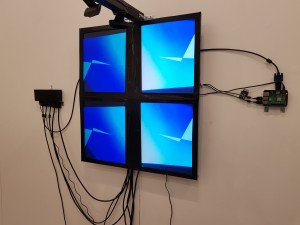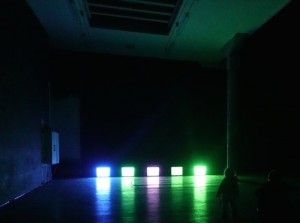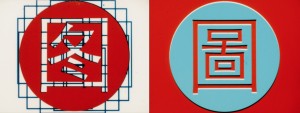Laura Denning – Rhyne and Huish
40 minute sound walk.
 A rhyne (pronounced reen) is a ditch or canal used to transform areas of wetland into pasture. Huish is a habitational name that may refer to small areas of woodland. Both terms are most prevalent in Somerset. Fog is low-lying, the moisture being generated locally. The only difference between mist and fog is visibility. Rhyne and Huish is an audio geonarrative created specifically for a walk around Newton Park, which transports listeners into the watery worlds of the Somerset Levels, using sound to create an experience of being deep within the Avalon Marshes on a murky autumnal afternoon, and to offer the opportunity to become ‘lost’ in the fog, and therefore in space and time.
A rhyne (pronounced reen) is a ditch or canal used to transform areas of wetland into pasture. Huish is a habitational name that may refer to small areas of woodland. Both terms are most prevalent in Somerset. Fog is low-lying, the moisture being generated locally. The only difference between mist and fog is visibility. Rhyne and Huish is an audio geonarrative created specifically for a walk around Newton Park, which transports listeners into the watery worlds of the Somerset Levels, using sound to create an experience of being deep within the Avalon Marshes on a murky autumnal afternoon, and to offer the opportunity to become ‘lost’ in the fog, and therefore in space and time.
Biography
Laura Denning is the recipient of the Bath Spa University Research Centre for Environmental Humanities inaugural PhD Studentship – practice-led (due to complete 2019), and has recently joined the Geography Department as an Associate Lecturer.
https://lauradenningartworks.weebly.com/
Henry James – Quadrant
 Multi-screen installation exploring the algorithmic workforce that governs our online expierence. Combining video feedback and algorithmic selection the piece exploits psuedo-randomness in order to generate form and pattern.
Multi-screen installation exploring the algorithmic workforce that governs our online expierence. Combining video feedback and algorithmic selection the piece exploits psuedo-randomness in order to generate form and pattern.
Biography
Bath Spa University Creative Music Technology graduate from South Wales currently residing in Bristol. Developing a multidisciplinary skill set has been my focus since graduating through combing sound, video and programming. Integral to my practice is cultivating an environment where work can grow and evolve. Through selectively recursive processes I aim to bring out the best traits and motifs until a completeness is felt.
Brian McKenna – Continuously Variable Colour-Field (2017)
 medium: variable dimensions, custom electronics, CRT monitors, multichannel audio.
medium: variable dimensions, custom electronics, CRT monitors, multichannel audio.
A system of analogue electronics for converting 5 channels of audio into 5 channels of CRT video. After some filtering and dynamics processing, the high, mid, and low audio frequencies of each audio channel speak directly as the Red, Green, and Blue channels of each video monitor. The installation serves to illustrate the structural and tonal elements of a multichannel electronic music composition.
Biography
Brian D. McKenna was born in Ottawa in 1975, he grew up in the UK and Canada. He studied Music and Fine Arts at the University of Lethbridge, Canada towards a multi-disciplinary BFA. In 2002 he relocated to Amsterdam, Netherlands and followed an MFA at the Sandberg Institute. Since then he continues to live and work in Amsterdam.
Through the use of mostly timebased media, McKenna’s work explores intersections between hearing and vision; the visual arts and music; the processes of translating information from one medium to another and their by-products. This work takes on the form of single and multichannel audiovisual installations of fixed media, reactive environments, and live performance. McKenna works both individually and collaboratively with an emphasis on experimental investigations.
A recurring theme in McKenna’s work deals the politics of perception and the power of various media over the formation of collective and individual experience. His early video works, for example, explored notions of advertising, brainwashing, and mind-control through the use of hypnotic audio-visual abstractions and repetitive trance-inducing temporal structures. In a similar vein, his more recent works investigate the foundational nature of ideologies and political narratives in affecting perception and the creative role of art and technology (artists and technologists) in defining who we are and the world we live in.
Lily Sheng – Change
 16mm double projection
16mm double projection
‘Change’ is a text animation that deconstructs and manipulates Chinese language in its representation of morphology, Taoist principles, and celestial cycles of time. The title refers to the I Ching, the Book of Changes, and 变 (traditional: 變), the Chinese word for ‘change’, in its translation that implies ‘transformation’. The film structure surveys Chinese seal script, Traditional Chinese, and Simplified Chinese, repeating 64 variations of 8 cosmic colors – red, green, blue, cyan, magenta, yellow, black, and white. Each string of characters correspond to a revolution of time in lunisolar and astronomical denominations. The allegorical usage of radicals and colors convey a universal interconnectivity, articulating meanings outside the confines of literacy, acting instead as a cryptogram, machine/mind symbiosis, series of rituals, and play of metronomic afterimages.
Biography
Lily Jue Sheng makes moving images with film, video, 2D mixed media, and multi-projection performance & installation. She graduated from the School of the Museum of Fine Arts in Boston, MA, and is currently based in Brooklyn, NY. She exhibits in a wide range of contexts such as museums, galleries, universities, film festivals, theaters, electronic billboards, and projection mappings for unique spaces. Her work has shown at the Whitney Museum of American Art, Parrish Art Museum, Microscope Gallery, Eyebeam, Pioneer Works, and the Knockdown Center in New York; the Museum of Fine Arts in Boston; the Musée d’art contemporain de Montréal in Montreal; the 1933 Slaughterhouse (老场坊) and West Bund Art & Design Fair in Shanghai; and 3331 Arts Chiyoda in Tokyo.
Ping-Sheng Wu – Reforming
 From the point of view of totality, our world is just a short period of time. Where is the beginning of time? What would be before the Big Bang? These questions might break the linear concept of time that we rely on. If we believe that time began from singularity, it means there is no ‘before’. The past is not gone, the future is not the future. How do we explore the relationship between time and space? This piece is an attempt to explore these questions in digital space.
From the point of view of totality, our world is just a short period of time. Where is the beginning of time? What would be before the Big Bang? These questions might break the linear concept of time that we rely on. If we believe that time began from singularity, it means there is no ‘before’. The past is not gone, the future is not the future. How do we explore the relationship between time and space? This piece is an attempt to explore these questions in digital space.
Biography
Ping-Sheng Wu is a Taipei-based artist whose creative process focuses on sound. His practice takes on a variety of forms including music and soundtrack composition across a number of genres, from experimental and ambient to rock and roll, with live performance and sound installation being a primary focus. The field of visual arts has been a long-held concern in his search for how sound expands and extends through the senses. Through observations of sound as a physical property of an environment and as an object of analysis through digital processing, he has continued to re-encounter senses of sound as it is naturally or artificially translated and substituted in various forms of media.